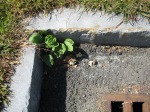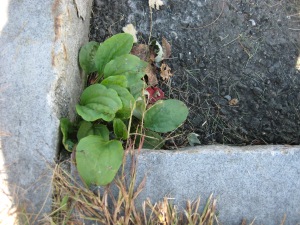Cruising down the Massachusetts Turnpike on a nice fall day. I’ve travelled this way so often I can recite the stops on the toll card from memory. The New England town names have a pleasing sort of rhythm to them: Framingham, Natick, Ludlow, Palmer, Weston, Newton…
 Eventually I stop, as all travellers do, at one of the rest areas. Impossible to tell them apart, they all look alike. Not very restful places, really. Not much here for an enterprising botanist. Lots of green, all of it mowed close as a crew cut. Weed whackers have whacked every weed into submission. The shrubs are all planted at right angles to each other.
Eventually I stop, as all travellers do, at one of the rest areas. Impossible to tell them apart, they all look alike. Not very restful places, really. Not much here for an enterprising botanist. Lots of green, all of it mowed close as a crew cut. Weed whackers have whacked every weed into submission. The shrubs are all planted at right angles to each other.
There’s just a speck of wayward green, sprouting out of a crack in the cement, in a corner by a storm sewer drain. Surely the least inviting habitat for a seed to germinate in. But there it grows, a little cluster of floppy oval leaves.  Waybread. The plant that grows in the ways that people travel.
Waybread. The plant that grows in the ways that people travel.
This little plant springs up in paths and roads and trails—not just along the edges, but spang in the middle. The tough, ribbed leaves hug the earth, and the plant survives—even thrives!—when it’s trampled, mowed over, driven on.  The flat rosette of leaves dodges mower blades with ease, the long taproot sucks up every bit of moisture. A thousand years ago the Anglo-Saxons named it waybread, since it always grew along their ways and paths.
The flat rosette of leaves dodges mower blades with ease, the long taproot sucks up every bit of moisture. A thousand years ago the Anglo-Saxons named it waybread, since it always grew along their ways and paths.
It’s generally known as plantain now—common plantain, Plantago major. “Planta” in Latin refers to the sole of a shoe. The ancient Romans were well familiar with plantain as a common herbal medicine, and they must have seen this little traveler poking up between the cracks in their well-paved roads.
In the sixteenth century, plantain came across the ocean with the first settlers. Native Americans called it something like Englishman’s Foot, or White Man’s Footstep, since it seemed to spring up wherever the annoying newcomers trod.
What else is there about common old plantain? I google it just for fun. Yep, it’s edible, as you’d guess from the name waybread, a mildly nutritious salad green. I’m sure not going to nibble a leaf out of the sewer drain, with all these cars racing by, spewing exhaust. It’s also used medicinally, but that’s no surprise—seems as though almost all plants are recommended medicinally on some website or other. Astringent, diuretic, yawn.
Aha, but wait–a tenth century Anglo-Saxon manuscript in the British Library has this to say:
” A worm [meaning a dragon] came crawling and tore a man asunder. Then took Woden nine magic twigs and smote the serpent that he in nine pieces dispersed. Now these nine herbs have power…
And from the bloody pieces of the dragon came the gods’ gift to humans: nine sacred plants that cure wounds, poison and infection.
Plantain has been a traditional remedy for centuries, across many cultures, for everything from sword cuts to mosquito bites. It does seem to have antibiotic properties–mild to be sure compared to penicillin, but sacred and magical enough in long-ago times.
Plantain: travelling companion of a Roman road-builder, a Native American wanderer, an Anglo-Saxon dragon-hunter, and me.
And this is it, you see–this is why I love botany. The wild plants of the world don’t change the way the rest of the world does. The Native American hunting trails, the stone-paved Roman roads, the ancient English path through the dripping oak woods are long gone, and the Mass Pike is pretty dull. But plantain still goes in the way of the traveler.






Recent Comments